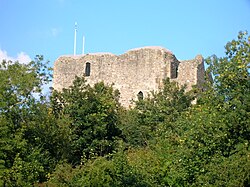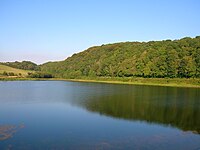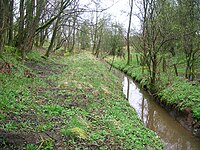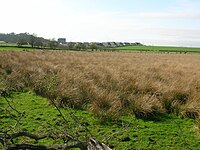Dundonald, Ayrshire
| Dundonald | |
| Ayrshire | |
|---|---|
 Dundonald Castle | |
| Location | |
| Grid reference: | NS366343 |
| Data | |
| Local Government | |
| Council: | South Ayrshire |
Dundonald is a village in Ayrshire, found a little south of Irvine. It is best known for Dundonald Castle, which was built in the 14th century by King Robert II, on the ruins of a castle built earlier (in 1260 by his grandfather, Alexander Comyn, 2nd Earl of Buchan. The castle served the Scottish kings for 150 years.
The ruins of Old Auchans Castle lies nearby, the previous residence of Susanna Montgomery, Lady Eglinton.
Since 1945, Dundonald has been primarily a commuter town for the larger towns of Ayrshire.
Contents
Parish church
The present parish church was built in 1803, though it succeeds predecessors; the first recorded church in Dundonald is recorded in 1229 when it was gifted to the convent at Damilling and later to Paisley Abbey, to which it belonged until the Reformation.[1]
New Auchans House
New Auchans HouseNS3603534900 was built in 1819, designed by William Wallace.[2] The house was built for the Earl of Eglinton's commissioner Monteaulieu Burgess of Coilsfield, followed in 1885 by the Hon. Greville Richard Vernon, son of the 1st Lord Lyveden. Major Coats of the Paisley thread manufacturers tenanted the house at one time, as did the Beattie banking family.[3] In 1947 the Earl of Eglinton sold the house to the Earl of Dundonald.[4] The house was then sold by the Earl of Dundonald in 1960 to a builder and finally demolished in 1970 and the site has since been developed as a housing estate on the edge of the town.[5][6]
Natural history
Dundonald Woods cover one of the most extensive areas of elm-dominated woodlands in Ayrshire. Ash, oak and sycamore are also abundant; much of the policies are composed of derelict-coppiced-type growth from trees felled in the Second World War. Some conifer plantations are present. Wetland habitats are also present, including the Collennan Reservoir, springs and a eutrophic loch, contributing to the high biodiversity of the site. Dog's Mercury, Wood Melick, Broad-leaved Helleborine, and Giant Bellflower are amongst the significant plants present.[7]
The small Galrigs Loch, Ayrshire was located near Laurieston Farm and the ruin of Lochside Farm; it is now evident as a marshy area dominated by rushes. Galrigs was the old name for the lands of Newfield.
The Slough of Despond
On the boundary of Dundonald and Symington parishes lies an area known as the "Slough of Despond", a nicknamed taken from the Slough of Despond in John Bunyan's Pilgrims Progress (into which the character Christian sinks under the weight of his sins and his sense of guilt for them). It gained its name in the nineteenth century.
The burn in this area, rising near the old Broadhirst Farm, has long been known as the Slough, meaning a marsh or quagmire. Quite how the name "Slough of Despond" was attached to the resultant marshland is uncertain, but it is recorded since the mid-19th century and may be linked to the nearby limekilns that were generally notorious for the acrid 'hell-like' smoke that issued from them.
The Slough Burn still rises from the marshy area below the Broadhirst Woods, however the limestone quarry that served the limekilns is now abandoned, surviving as an area rich in wildlife, containing old woodland indicator plants such as Wood Anemone, Bluebell, Wood Sorrel, Dog's Mercury, Herb Robert and other species. The Slough Burn runs down past Dankeith House, Templeton and Fortacres, Todrigs and through Caprington, to join the River Irvine near Gatehead.
Events
- August - "Dundonald Highland Games" - Traditional Scottish Highland Games.
- May - "Dundonald Music Festival" - A weekend of booked bands and jam sessions.
Pictures
References
- Notes
Books
- Campbell, Thorbjørn (2003). Ayrshire. A Historical Guide. Edinburgh : Birlinn. ISBN 1-84158-267-0.
- Edwards, Steven (1981). Important Woodland sites for Wildlife conservation in Ayrshire. Scottish Wildlife Trust.
- Love, Dane (2003). Ayrshire : Discovering a County'. Ayr : Fort Publishing. ISBN. 0-9544461-1-9.
- Love, Dane (2005). Lost Ayrshire : Ayrshire's Lost Architectural Heritage. Edinburgh : Birlinn Ltd. ISBN. 1-84158-3561-1.
- Stewart, Gordon (2004). Old Auchans House, Dundonald. Pub. Friends of Dundonald Castle.
| ("Wikimedia Commons" has material about Dundonald, Ayrshire) |









